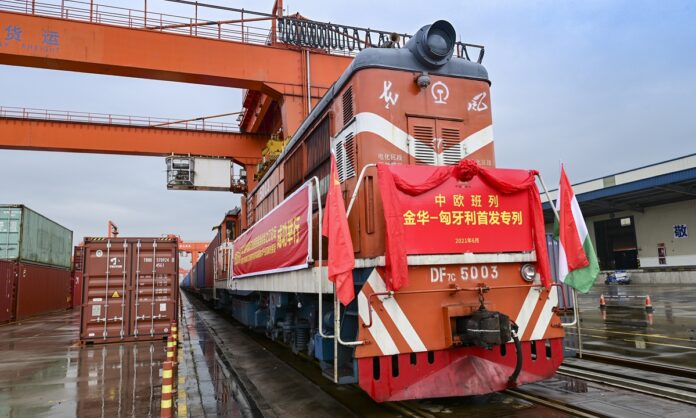China’s Xi’an, the capital of the northwestern Shaanxi Province, is fast transforming into a centre of regional trade with freight trains becoming the biggest tool of China-Eurasia trade. China-Eurasia freight trains have added a new impetus to the Belt and Road Initiative — a vision that Chinese President Xi Jinping launched back in year 2012.
A visit to the China-Euro Cargo Trains Realignment Centre, International Port Zone, Xi’an, reveals that Xi’an, the starting point of the Old Silk Road, has again become a hub of transregional and international trade – thanks to the freight trains operations which have restored Xi’an’s significance as hub of regional trade.
This freight train system in Xi’an is a part of a major strategy under Belt and Road Initiative (BRI) linking China with Europe and Central Asian countries through road and rail networks. Xi’an, being starting point of old Silk Road, is heart of these regional and transregional linkages.
One can imagine the significance of the China-Euro Cargo Trains Realignment Centre with the fact that the China-Europe Railway Assembly Section at the International Port spans over 5,600 acres of land. Over 10,000 trains are dispatched to various overseas destinations across Europe every year.
China-Europe Railway Assembly Section is China’s biggest railway assembly section. It also handles 25 percent trade of overall trade of China to overseas destinations.
Kazakhstan is the first major destination for the freight trains departing from Xi’an while the biggest trading product is transportation of used cars. Majority of used cars are Energy Vehicles (EV) cars while wood is also transported to Eurasian countries like Russia, Kazakhstan, Romania, etc.
With the fast transforming world, EV cars are becoming a major source of trade due to fast depleting oil resources and skyrocketing prices of oil products. Hence, used EV cars are selling in Eurasian countries like hot cakes.
One can understand the quantum of trade through transregional trade via China-Euro Cargo Trains in Xi’an that total revenue generated was US$ 3.55 billion in year 2023.
In January and February of this year, a Chinese railway firm opened new routes connecting Xi’an, Chongqing, and Yiwu in China to Tbilisi in Georgia, Baku in Azerbaijan, and Istanbul in Turkey. Approximately 3,000 trains departed for these destinations.
In the first two months of 2024, the freight train service made 2,928 trips in total, delivering 317,000 containers of products. This represents a yearly increase of 9% in trip frequency and 10% in cargo volume. In order to boost trade between China and Pakistan to unprecedented levels, China also intends to launch a new freight train route to Pakistan from its China-Euro Cargo Trains Realignment Centre in Xi’an.
China plans to start a hybrid trade route from Xi’an to Pakistan soon. Containers would be transported through freight trains to Kashgar from Xi’an. The goods would be shifted by road from Kashgar to Rawalpindi and from where freight trains would again transport goods to various destinations in Pakistan and beyond.
Other than Xi’an, China is also promoting regional connectivity with central Asian states through a base in Xinjiang Uyghur Autonomous Region. China signed a new trilateral intergovernmental agreement for China-Kyrgyzstan-Uzbekistan railway project last year in Beijing.
This demonstrates the Chinese leadership’s dedication to regional collaboration with the nations of Central Asia in order to expedite the development of transportation infrastructure in order to construct a transportation corridor. This shows the determination and will for joint development that would benefit all three of the partner nations as well as other countries.
The agreement follows one that was reached during the September 2022 Shanghai Cooperation Organization (SCO) Summit in the Uzbek city of Samarkand for the construction of a new railway. Following field investigations carried out in December 2023 by Chinese engineers, the feasibility assessment was completed. Starting in Kashgar, the proposed railway network would travel via Torugart, Kosh-Dobo, and Kazarman in Kyrgyzstan before arriving at Andijan in Eastern Uzbekistan.
The railroad connection would shorten the journey for freight by eight days, severing the path between China and Europe by at least 900 kilometres. The 523-kilometer railway corridor has the promise of a better future owing to the approaching economic paybacks it would bring, and it would significantly increase trade and economic cooperation between the central Asian nations along its course.
A previous statement said that the proposed railway route would be a US$8 billion cooperative venture involving three nations. $4.7 billion of the entire sum has been set aside for the rail route in Kyrgyzstan.
One can comprehend that China, being one of the most-unprecedented tales of economic development in the recent history, is now sharing its fruit of development with the less developed and privileged nations through trade and linkages.
The vision of Chinese leadership and the will of its people cannot be defeated by hatching conspiracies and spreading fake news. The world is, hence, eager to trade, cooperate and collaborate with China. This is why countries from Asia to Africa are joining hands with China to shape a community with a shared future for the mankind.























